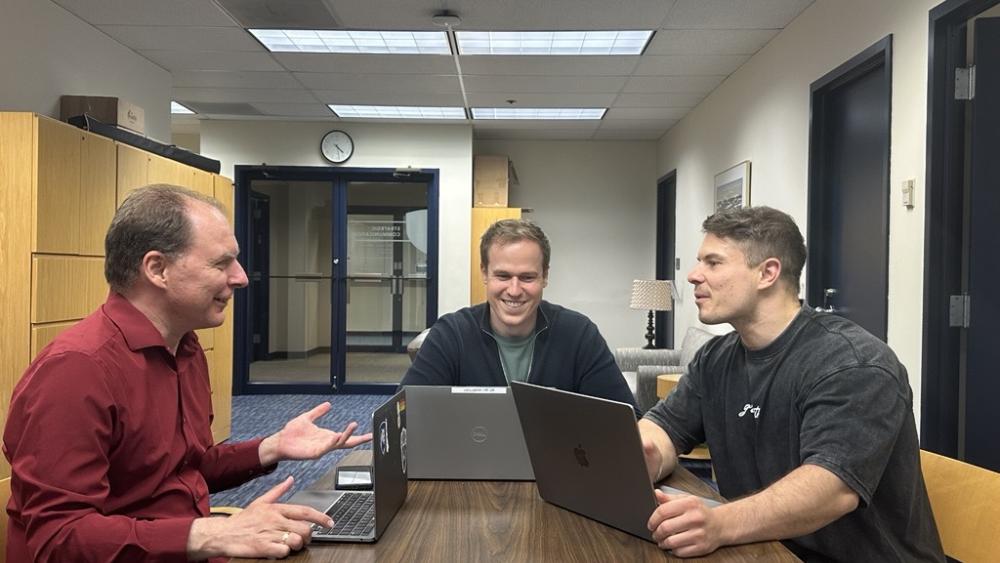MALVERN, Pa. — As people increasingly use artificial intelligence (AI) in various areas of life to save time or improve performance, the influence of AI systems is increasing, as is the risk of unreliable results in high-stakes decision-making, such as those involving medical or financial choices. AI agents, such as autonomous trading robots or various diagnostic tools, are designed to learn, evolve and operate with little or no direct human involvement. So, what can technologists do to ensure that AI complies with ethical values for the public good?
A team, including researchers from Penn State, published a paper in the Journal of Cybersecurity and Privacy to explore ways in which blockchain – the technology behind cryptocurrency – could help enforce the ethical boundaries of AI systems.
In the Q&A session below, Dusan Ramljak, study co-author and assistant professor of software engineering at Penn State Great Valley, discussed the framework he and his team developed to study how to use blockchain to align AI with human ethics.
Q: Why is AI behavior such a pressing problem?
Ramljak: AI systems are trained to act in a certain way within specific parameters. If the parameters change, for example when implemented in larger systems, they can act unpredictably and contrary to human values – for example, making false claims when processing sensitive health data or misinformation when recommending inappropriate medical treatment. The consequences can be dangerous.
As we delegate more and more tasks to AI, we must find ways to ensure that we maintain control over these systems and facilitate ethical conduct. AI can help us increase the efficiency of daily life, but we must use it responsibly by providing an appropriate testing environment, predicting its behavior in advance, and ensuring AI aligns with human values.
Q: People often think of blockchain in relation to cryptocurrency. How can blockchain help AI operate ethically?
Ramljak: Blockchain creates secure, decentralized digital records through cryptography, requiring transparent tracing of data from input to output, with tamper-proof logs. Many AI systems lack the kind of transparency, security, and decentralized control that blockchain offers. By combining AI with blockchain, we can create systems where decisions are consistent and traceable, and where operational rules and data are more difficult to manipulate.
Blockchain-based consensus mechanisms allow a wide range of participants to vote on ethical rules, which are then stored as “smart contracts”. Smart contracts are machine-enforceable ethics or rules that execute automatically. These mechanisms promote decentralized collaboration and democratization in the development of artificial intelligence systems and ensure that machines respect certain limits. Blockchain security features also make it more difficult for malicious actors to manipulate training data, which could cause AI systems to yield unreliable or harmful results.
Q: What is the framework that your team has developed to study the uses of blockchain to put ethical guardrails on the behavior of AI systems?
Ramljak: Our research team, consisting of Maryam Roshanaei, assistant professor of information technology and cybersecurity analytics and operations at Penn State Abington, Jainil Kakka, master’s student in data analytics, Alexander Neulinger and Lukas Sparer, doctoral students from the University of Vienna, and Dragutin Ostojić, doctoral student from the Department of Mathematics and Computer Science at the Faculty of Science and the Department of Mathematics and Computer Science at Kragujevac University, reviewed more than 7,000 studies and developed a framework to guide future research on how blockchain can facilitate ethical compliance in AI systems by supporting secure and transparent operations and ensuring accountability.
One study suggested that blockchain could be used to verify AI input data and record AI output, which would help ensure traceability of decision-making. Another study proposed that blockchain could support the reputation systems of AI agents, providing incentives for ethical behavior and denying resources for deceptive or non-compliant actions.
We also noted some gaps in the literature, which is why we proposed a three-tiered analytical framework for further exploration of blockchain uses for AI alignment:
- Micro-level analysis: technical and coding protocols to secure user data
- Meso-level analysis: Blockchain-based AI use cases in various industries, such as financial services and healthcare, with requirements specific to the unique needs of these industries
- Macro-level analysis: moral principles and international legal and cultural norms that govern ethical and sustainable uses of emerging technologies in the public interest. The European Union’s Artificial Intelligence Act is an example of global regulation intended to support the trustworthy development and responsible use of AI systems through strict governance and transparency requirements.
Q: What are the disadvantages of using blockchain-based AI?
Ramljak: Large-scale blockchain and AI systems can be power hungry. Additionally, privacy must be protected so that making AI more transparent does not mean exposing sensitive data. And different countries and cultural regions may prioritize values differently, from privacy to fairness. Alignment frameworks must therefore be flexible enough to work across cultures and legal systems.
Q: What future research is needed to explore the alignment of blockchain-based AI with ethics?
Ramljak: For future research directions, we need to develop multi-level frameworks that integrate micro-level security and privacy mechanisms, meso-level sectoral governance, and macro-level legal constraints into a single, adaptable structure.
The convergence of blockchain and AI could bring us not only increased reliability of technical systems, but also new modes of human-centered governance, ensuring accountability at scale. Blockchain gives us tools to develop and use AI in ways that prioritize human values and societal well-being.




